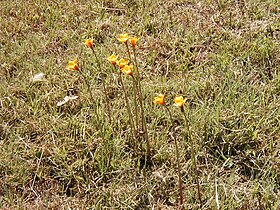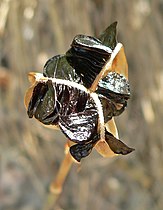| Zephyranthes tubispatha | |
|---|---|

| |
|
Scientific classification
| |
| Kingdom: | Plantae |
| Clade: | Tracheophytes |
| Clade: | Angiosperms |
| Clade: | Monocots |
| Order: | Asparagales |
| Family: | Amaryllidaceae |
| Subfamily: | Amaryllidoideae |
| Genus: | Zephyranthes |
| Species: | Z. tubispatha
|
| Binomial name | |
| Zephyranthes tubispatha (L'Hér.) Herb.
| |
| Synonyms [1] | |
| |
Zephyranthes tubispatha, synonym Habranthus tubispathus, [1] the Rio Grande copperlily or Barbados snowdrop, [2] is a species of flowering plant in the family Amaryllidaceae. It is a perennial bulb native to southern South America ( Brazil, Argentina, Paraguay and Uruguay). It is widely cultivated as an ornamental and reportedly naturalized in the southeastern United States ( Texas, Louisiana, Alabama, Georgia, Florida), much of the West Indies as well as Bermuda, eastern Mexico, India, Easter Island, and central Chile. [3]
Description
Flowers are produced sporadically during late summer and autumn, singly on stems 10 to 20 centimetres (4 to 8 in) tall. Flowers are usually yellow with copper tones on the outside, with tepals about 3 centimetres (1.2 in) long, fused for a short distance at the base to form a tube. As with all former Habranthus species, the flowers are not upright on the stem but held at a slight angle. The leaves are not normally present at flowering time, appearing later; they are narrowly linear. [3]
Chemical composition
Cultivation
Zephyranthes tubispatha tolerates some frost down to 0 °C (32 °F) if planted in a sheltered sunny position, but will not survive being frozen. It seeds freely. A form with pinkish flowers is grown as var. rosea, but may be a hybrid. [3]
Z. tubispatha has gained the Royal Horticultural Society's Award of Garden Merit. [2] [5] The name Habranthus andersonii is commonly found in horticultural sources.
-
Growing in Denton, Texas, USA
-
Growing in Denton, Texas, USA
-
Seed capsules
-
Seeds
-
Growing at TWU in Denton, Tx.
References
- ^ a b "Zephyranthes tubispatha (L'Hér.) Herb". Plants of the World Online. Royal Botanic Gardens, Kew. Retrieved 2021-12-31.
- ^ a b "RHS Plant Selector - Habranthus tubispathus". Retrieved 5 July 2020.
- ^ a b c Mathew, Brian (1987), The Smaller Bulbs, London: B.T. Batsford, ISBN 978-0-7134-4922-8, p. 101
- ^ "Katoch D and Singh B, Med Aromat Plants" (PDF).
- ^ "AGM Plants - Ornamental" (PDF). Royal Horticultural Society. July 2017. p. 44. Retrieved 3 March 2018.
| Zephyranthes tubispatha | |
|---|---|

| |
|
Scientific classification
| |
| Kingdom: | Plantae |
| Clade: | Tracheophytes |
| Clade: | Angiosperms |
| Clade: | Monocots |
| Order: | Asparagales |
| Family: | Amaryllidaceae |
| Subfamily: | Amaryllidoideae |
| Genus: | Zephyranthes |
| Species: | Z. tubispatha
|
| Binomial name | |
| Zephyranthes tubispatha (L'Hér.) Herb.
| |
| Synonyms [1] | |
| |
Zephyranthes tubispatha, synonym Habranthus tubispathus, [1] the Rio Grande copperlily or Barbados snowdrop, [2] is a species of flowering plant in the family Amaryllidaceae. It is a perennial bulb native to southern South America ( Brazil, Argentina, Paraguay and Uruguay). It is widely cultivated as an ornamental and reportedly naturalized in the southeastern United States ( Texas, Louisiana, Alabama, Georgia, Florida), much of the West Indies as well as Bermuda, eastern Mexico, India, Easter Island, and central Chile. [3]
Description
Flowers are produced sporadically during late summer and autumn, singly on stems 10 to 20 centimetres (4 to 8 in) tall. Flowers are usually yellow with copper tones on the outside, with tepals about 3 centimetres (1.2 in) long, fused for a short distance at the base to form a tube. As with all former Habranthus species, the flowers are not upright on the stem but held at a slight angle. The leaves are not normally present at flowering time, appearing later; they are narrowly linear. [3]
Chemical composition
Cultivation
Zephyranthes tubispatha tolerates some frost down to 0 °C (32 °F) if planted in a sheltered sunny position, but will not survive being frozen. It seeds freely. A form with pinkish flowers is grown as var. rosea, but may be a hybrid. [3]
Z. tubispatha has gained the Royal Horticultural Society's Award of Garden Merit. [2] [5] The name Habranthus andersonii is commonly found in horticultural sources.
-
Growing in Denton, Texas, USA
-
Growing in Denton, Texas, USA
-
Seed capsules
-
Seeds
-
Growing at TWU in Denton, Tx.
References
- ^ a b "Zephyranthes tubispatha (L'Hér.) Herb". Plants of the World Online. Royal Botanic Gardens, Kew. Retrieved 2021-12-31.
- ^ a b "RHS Plant Selector - Habranthus tubispathus". Retrieved 5 July 2020.
- ^ a b c Mathew, Brian (1987), The Smaller Bulbs, London: B.T. Batsford, ISBN 978-0-7134-4922-8, p. 101
- ^ "Katoch D and Singh B, Med Aromat Plants" (PDF).
- ^ "AGM Plants - Ornamental" (PDF). Royal Horticultural Society. July 2017. p. 44. Retrieved 3 March 2018.




